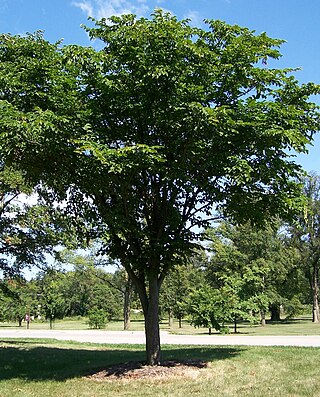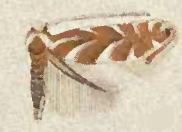
The elm cultivar Ulmus 'Hillieri' arose from a chance seedling at Hillier's Pitt Corner nursery near Winchester, England, in 1918, and was marketed from 1928 as Ulmus hillieri, a name accepted by Christine Buisman in her 1931 labelling of a specimen in France. Since at least 1944 the tree has been determined a form of Ulmus × hollandica, its designation at Kew Gardens, in Green, and in later Hillier catalogues. In 1940, 'Hillieri' was noted as being a hybrid of uncertain origin. Krüssmann notes that for a time the tree was listed by Hilliers as U. × hillieri.
The Chinese Elm cultivar Ulmus parvifolia 'Emer I' or 'Emerald Isle' was cloned from a tree planted circa 1920 on the University of Georgia campus at Athens.

The American elm cultivar Ulmus americana 'Aurea' was cloned from a tree discovered by F. L. Temple in Vermont at the end of the 19th century.
The American Elm cultivar Ulmus americana 'Kimley' was cloned c.1957 by the Sheridan Nurseries, Mississauga, Canada, from a large tree found near Oshawa, Ontario, Canada.

Ulmus laciniata var. nikkoensisRehder, the Nikko elm, was discovered as a seedling near Lake Chūzenji, near Nikkō, Japan, and obtained by the Arnold Arboretum in 1905. The taxonomy of the tree remains a matter of contention, and has been considered possibly a hybrid of U. laciniata and U. davidiana var. japonica. However, in crossability experiments at the Arnold Arboretum in the 1970s, U. laciniata, a protogynous species, was found to be incompatible with U. davidiana var. japonica, which is protandrous.

Ulmus parvifolia, commonly known as the Chinese elm or lacebark elm, is a species native to eastern Asia, including China, India, Japan, Korea, and Vietnam. It has been described as "one of the most splendid elms, having the poise of a graceful Nothofagus".
The Japanese Elm cultivar Ulmus davidianavar.japonica 'Reseda' is an American cultivar raised by the Wisconsin Alumni Research Foundation (WARF) as clone no. 43–8. 'Reseda' was grown from seed sent from Hokkaido, Japan, in the late 1950s. Although not released in its own right, it was destined to become the female parent of the highly successful hybrid cultivars 'New Horizon' and 'Rebona'.
Stigmella kazakhstanica is a moth of the family Nepticulidae. It is found in Astrakhan, Kazakhstan and Turkmenistan.
Phyllonorycter acaciella is a moth of the family Gracillariidae. It is found in southern Europe, but not on the Iberian Peninsula and Balkan Peninsula.

Phyllonorycter agilella is a moth of the family Gracillariidae. It is found in Latvia central Russia, Pyrenees, Italy and Bulgaria and from France to eastern Russia.

Phyllonorycter tristrigella is a moth of the family Gracillariidae. It is known from all of Europe, except the Iberian Peninsula and the Balkan Peninsula, east to the European part of Russia. It was also recorded from Japan, but this is a misidentification of Phyllonorycter laciniatae.

Phyllonorycter schreberella is a moth of the family Gracillariidae. It is known from Europe, except northern Europe, Ireland and the Balkan Peninsula.
Phyllonorycter ulmi is a moth of the family Gracillariidae. It is known from Japan, Korea and the Russian Far East.
Phyllonorycter laciniatae is a moth of the family Gracillariidae. It is known from Hokkaidō island of Japan and from the Russian Far East.
Caloptilia ulmi is a moth of the family Gracillariidae. It is known from China, Japan and the Russian Far East.

Phyllonorycter argentinotella is a moth of the family Gracillariidae. It is known from Québec in Canada and Illinois, Kentucky, Pennsylvania, New York, Vermont, Connecticut and Massachusetts in the United States.
Phyllonorycter occitanica is a moth of the family Gracillariidae. It is known from Texas, United States.

Cameraria ulmella is a moth of the family Gracillariidae. It is known from Ontario and Québec in Canada, and Texas, Kentucky, Maine, Maryland, Michigan, New York, Georgia, Illinois and Connecticut in the United States.
Phyllonorycter valentina is a moth of the family Gracillariidae. It is known from the Russian Far East.
Phyllonorycter pumilae is a moth of the family Gracillariidae. It is known from the Russian Far East, Japan and north-western China.





